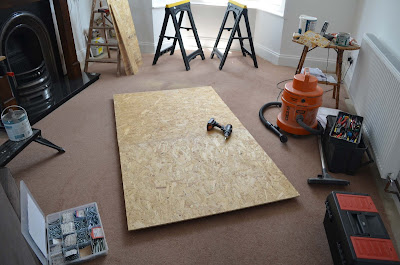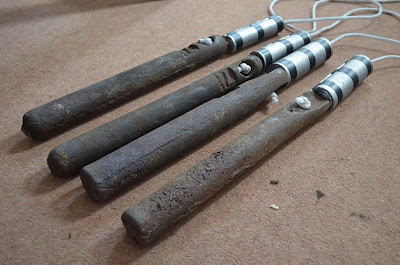Continuing with the bay window, I've rubbed down, primed and undercoated the insides of the fixed panes on either side of the main sashes.
Now for the sashes... these were removed in exactly the same way as all the others. I get the impression that these have not been removed for a very long time, if ever. The casings and parting beads had never been painted in the centre where the sashes prevent access.
The parting beads were showing signs of wood rot and the timber was in generally poor condition.
I had to batten two pieces of OSB together to make a temporary board. This was tacked into position using several wooden wedges, nailed into the casing where the parting bead fits.
The sashes could then be stripped down, repaired, sanded and primed, along with the new parting and staff beads.
A bit of filler was needed to tidy up the weight pocket covers...
...a coat of primer and they're as good as new.
And meanwhile, the window casing was cleaned up, filled, sanded and primed.
As with all the previous windows, the sash counterweights were way too light. I had to add a total of about 7kg to balance them. Some scrap lead was sourced from Sandcast Lead in Wigston. This was a continuous sheet of lead and in good, clean condition so, rather than casting new weights, I decided to roll it.
First it was cut into pieces of the appropriate weights using a pair of tin snips. Then, using a lot of brute force, it was rolled around a 9mm dowel (to ensure an adequate aperture for the sash cord).
The rolled weights were then bound using electrical tape...
...and added to the original weights.
Once the window casing had been painted and was fully dry, the new brass pulleys were fitted.
The sashes and new beads could then be re-fitted.
Attention then turned to the outside. The paint was very flaky in places and gaps were starting to show on the corners of the uprights. At the bottom of the two front corners the timber had been replaced at some point. Although the paint was in poor condition, I decided to keep these pieces and repair them.
The two pieces were pinned in order to stabilise them and to provide a good key for the filler to attach to. Two part wood filler was then applied and, once set, sanded back to a smooth finish.
Elsewhere, there were isolated areas of rotten wood so these were dug out and filled.
Likewise, the cornice was secured by pinning, then filled and sanded.
A couple of coats of primer/undercoat followed by quick-dry topcoat had it looking a bit better.
And the inside was finished off with a couple of coats of Satinwood.
So, with the interior painting complete, the windows could now be dressed.
Jacqui sourced this decorative frosted film from Ebay...
...and applied it to the lower panes of glass.
The back door is badly rotting and is long overdue for replacement. By good fortune, we acquired a replacement which was almost a perfect fit, needing just the smallest amount of trimming. This also had a patch of rot in the same area as the old one, but nowhere near as bad so I set about repairing it.
First, all the soft timber was scraped out using a chisel.
This went quite deep, probably to about the centre of the timber. Unfortunately, it also took out a section of the moulding round the edge of the panel... this would have to be reconstructed.
The remaining exposed timber was given a generous coat of Wet Rot Wood Hardener and left to set.
Several layers of two part filler were then applied to build the profile back up.
This was then shaped using chisels and files, finished off with a fine sandpaper.
New rebates had to be cut into the frame for the new hinge positions and the old screw holes were plugged. The door could then be temporarily hung to check fitting. Just a few mm had to be shaved off the bottom of the door, to clear the threshold. The old door was put back on whilst the new one is painted.
The stone cills and lintels on the front of the house were looking a bit tired. The loose paint has been scraped away...
...and a coat of masonry paint applied...
A second coat will be applied when time permits.
And last, but not least, Jacqui has been sprucing up the fire surround using Wilko Jacobean Dark Oak wood dye.








































No comments:
Post a Comment